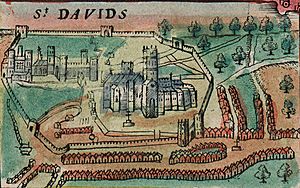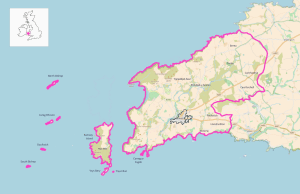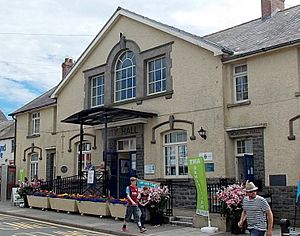St Davids facts for kids
Quick facts for kids St Davids
|
|
|---|---|
| City | |
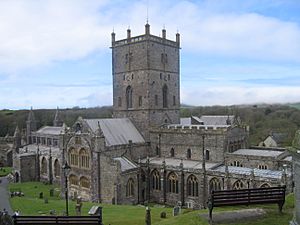 St Davids Cathedral |
|
| Area | 17.96 sq mi (46.5 km2) (community) 0.30 sq mi (0.78 km2) (urban area) |
| Population | 1,751 (2021) (community) |
| • Density | 97/sq mi (37/km2) |
| OS grid reference | SM755255 |
| • Cardiff | 90 mi (140 km) |
| • London | 220 mi (350 km) |
| Community |
|
| Principal area | |
| Ceremonial county | |
| Country | Wales |
| Sovereign state | United Kingdom |
| Post town | HAVERFORDWEST |
| Postcode district | SA62 |
| Dialling code | 01437 |
| Police | Dyfed-Powys |
| Fire | Mid and West Wales |
| Ambulance | Welsh |
| EU Parliament | Wales |
| UK Parliament |
|
| Welsh Assembly |
|
St Davids (also known as St David's) is a small but important city in Pembrokeshire, Wales. Its Welsh name is Welsh: Tyddewi, which means "David's house." The city is famous because it is the resting place of Saint David, who is the patron saint of Wales.
St Davids is special because it is the smallest city in the United Kingdom based on how many people live there. In 2021, about 1,751 people lived in the wider community area. It also has the smallest urban area. St Davids was first given city status in the 1100s. This was a tradition for towns that had a big church called a cathedral. The city lost its status in 1886 but got it back in 1994, thanks to Queen Elizabeth II.
Contents
A Look Back in Time
Early Days

The land around St Davids has signs of very old human activity, including sites from the Palaeolithic (Old Stone Age), Bronze Age, and Iron Age. However, it seems the Romans did not settle here much.
After the Romans left Britain, the area was known as Meneva or Mynyw. Some old writings say that Saint Patrick (the patron saint of Ireland) founded a church or monastery here around 470 AD, even before Saint David was born.
The Age of Saint David
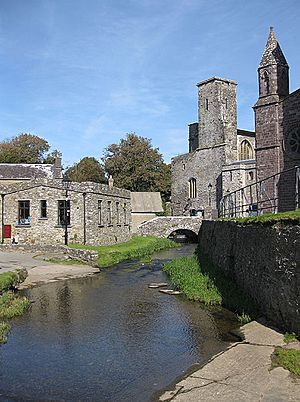
Saint David is believed to have been born around 500 AD near where the Chapel of St Non now stands. He was raised by his mother, Saint Non. David is thought to have started a community nearby before building a new church and monastery at a place called "Glyn Rhosyn," by the Afon Alun. This is where the famous Cathedral stands today.
Saint David became very famous across the Celtic church. He was a key leader in fighting against a religious idea called Pelagianism. It is said that he became the main bishop of the region, moving an important religious center to Mynyw (St Davids). Old Welsh stories even name Mynyw as one of the three most important royal courts in Britain, with King Arthur as a chief prince and David as the chief bishop.
A Place for Pilgrims
The religious settlement became known as Tyddewi (House of David). It quickly became a popular place for pilgrims (people who travel for religious reasons). This also made it a target for Viking attacks by the 800s.
St Davids was also known for its learning. When Alfred the Great, a famous English king, wanted to create a center of learning, he asked Asser, a scholar from St Davids, to join his court.
As the Normans moved into Pembrokeshire, St Davids became an important border town. The cathedral was rebuilt during the Norman period, and many parts of it today date back to the 1100s. It continued to hold many ancient holy items, including the remains of Saint David.
At its busiest, many important people visited St Davids, including kings like William the Conqueror in 1077, Henry II in 1171, and Edward I and Queen Eleanor in 1284. A Pope even said that two pilgrimages to St Davids were as good as one to Rome. This brought a lot of money to the city in the Middle Ages.
Decline and Rebirth
During the Reformation, the importance and income of St Davids began to shrink. Pilgrimages became less popular. Some English bishops who were in charge did not take good care of the cathedral or the city. For example, one bishop, William Barlow, sold the lead from the roof of the Bishop's Palace in 1536, which led to a long period of neglect.
By the 1800s, St Davids looked like a poor village, even though its cathedral was still grand. Many houses were in ruins. However, the unique history of the cathedral and city remained.
In the later 1900s, with better ways to travel and the rise of tourism, St Davids began to thrive again. Many of its 210 listed buildings (important historical buildings) are now cared for by Cadw and are open to visitors.
Geography and Nature
The St Davids area is located on a peninsula at the southern end of the Irish Sea. It sits between Cardigan Bay, St George's Channel, and St Brides Bay. The area includes not only the mainland but also several islands off the coast. Ramsey Island is the largest and the only one where people live.
The most western point of mainland Wales is at Pen Dal-aderyn. To the north, you can find Whitesands Bay and St Davids Head, which are well-known natural landmarks. Much of the mainland is used for farming, with small homes and campsites scattered around.
The St Davids Lifeboat Station, located at St Justinian, has saved many lives since 1869. The Irish Sea here has many rocks and islands and is known for its strong tides. The entire coastline around St Davids is part of the beautiful Pembrokeshire Coast National Park. The highest point in the area is Carn Llidi at 181 metres (594 ft).
City Status Explained
In the 1500s, a town was usually called a city by the English Crown if it had a cathedral and a special royal document called a charter. This rule changed in 1888, and St Davids lost its right to be called a city.
In 1991, the St Davids town council asked for city status to be given back. This was done in 1994, at the request of Queen Elizabeth II, to recognize its important Christian history. The Queen herself visited in 1995 to officially present the documents.
St Davids has the smallest population of all UK cities and the smallest urban area. However, because its official city area includes a large rural space and offshore islands, several other UK cities are actually smaller in total land area. For example, the City of London is smaller in area.
How the City is Governed
St Davids became a borough in 1115. This meant it had special rights and was governed by the Bishop of St Davids. Over time, these special powers changed.
In 1835, a report found that St Davids was a "municipal in name only" borough, meaning it didn't really have a local government like other towns. Its small population also meant it was not seen as important for reform. In 1886, any remaining legal rights of the borough were removed. This is when it lost its city status, as there was no official group to ask for it back.
Today, St Davids has a community council called St Davids City Council. This council has twelve councillors who help manage local services. The council is based at St Davids City Hall on High Street.
For bigger government services, St Davids is part of Pembrokeshire County Council.
Culture and Fun
Arts and Events
St Davids hosted the National Eisteddfod in 2002. This is a big Welsh festival of poetry, music, and dance. Important people, like Dr Rowan Williams, who later became the Archbishop of Canterbury, were welcomed into the Gorsedd of Bards during this event.
Helping Others
The St Davids Penknife Club is a group of people who raise money to help local groups and charities.
Sports
St Davids has a rugby union club called St. Davids RFC. They play in the Welsh Rugby Union League.
Tourism and Activities
Besides the famous cathedral, St Davids has 210 other listed historical buildings and structures. You can see the 14th-century Tower Gate and the ancient Celtic Old Cross. There are also art galleries to explore.
St Davids is a great place for walking and water sports. In 2019, it was named one of the best value beach destinations in Britain. Whitesands Bay, about two miles (three kilometres) west of St Davids, is very popular for water sports and is known as one of the best surfing beaches in Pembrokeshire.
Education
Ysgol Dewi Sant (St David's School) is the local secondary school for students aged 11 to 18. For younger children, from Reception to Year 6, there is Ysgol Bro Dewi (Dewisland School), which is a primary school.
Getting Around
The A487 road passes through St Davids. This road connects Fishguard and Haverfordwest. A bus route, TrawsCymru Connect route T11, runs along this road eight times a day.
Famous People from St Davids
Many notable people were born in St Davids:
- Asser (died around 909), a monk who was a mentor to King Alfred the Great and wrote about his life.
- Thomas Tomkins (1572–1656), a talented musician and composer.
- Richard Fenton (1747–1821), a Welsh lawyer, writer about places, and poet.
- Henry Hicks (1837–1899), a surgeon and geologist.
- Mary Keir (1912–2024), a Welsh supercentenarian (someone who lives to be over 110 years old).
- Kieran Evans (born 1969), a film director and screenwriter.
Sports Stars
- Ian Walsh (born 1958), a football player for the Wales national team.
- Rowland Phillips (born 1965), a rugby union player for Wales and later rugby league for Wales and Great Britain.
- Jo Price (born 1985), a Welsh rugby union player and former footballer.
- Jasmine Joyce (born 1995), a player for the Wales women's national rugby union sevens team and the British women's sevens team at the 2016 Summer Olympics.
Twin Towns
St Davids is twinned with these towns:
See also
 In Spanish: Saint David's para niños
In Spanish: Saint David's para niños



